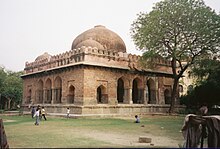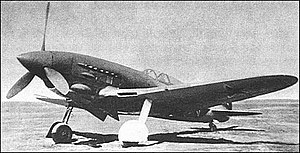니치포르 크레니치
Nichifor Crainic니치포르 크레니치 | |
|---|---|
 | |
| 대국민선전부 장관 | |
| 재직중 1940년 7월 4일 ~ 1940년 9월 14일 | |
| 수상 | 이온 기구르투 이온 안토네스쿠 |
| 선행 | 테오필 시도로비치 |
| 에 의해 성공자 | 위치 일시 중단 |
| 재직중 1941년 1월 27일 ~ 1941년 5월 26일 | |
| 수상 | 이온 안토네스쿠 |
| 선행 | 본인 |
| 에 의해 성공자 | 미하이 안토네스쿠 |
| 문화종교부 국무장관 | |
| 재직중 1940년 9월 14일 ~ 1941년 1월 21일 | |
| 수상 | 이온 안토네스쿠 |
| 장관 | 트라이안 브라일레아누 |
| 국민기독교당 공동대표 | |
| 재직중 1935년 7월 16일 1938년 2월 10일 | |
| 선행 | 옥타비아 고가(전국농민당 총재) A. C. 쿠자(국기독교방위연맹 회장) |
| 에 의해 성공자 | 없음(1938년 헌법에 의해 금지된 정당) |
| 개인 정보 | |
| 태어난 | 1889년 12월 22일 루마니아 왕국 기우르지우 주 불부카타 |
| 죽은 | 1972년 8월 20일 루마니아 사회주의 공화국 일포프 주 모고쇼아 |
| 정당 | 민족기독교방위연맹(1935년 이전) 국민기독교당(1935년-1938년) |
| 모교 | 부쿠레슈티 대학교 빈 대학교 |
| 직종. | 작가, 교수, 정치인 |
| 직업 | 신학자, 철학자 |
| 시리즈의 일부 |
| 루마니아의 파시즘 |
|---|
 |
| 시리즈의 일부 |
| 반유대주의 |
|---|
 |
| |
니치포르 크레니치(Nichifor Crainic,[1] 1889년 12월 22일 ~ 1972년 8월 20일)는 루마니아의 작가, 편집자, 철학자, 신학자이다.크레닉은 부쿠레슈티 신학대학과 키시너우 신학대학의 신학 교수이기도 했다.그는 중요한 인종차별주의 [2][3][4]이데올로기이자 극우 [5]정치인이었다.그는 루마니아의[6] 주요 파시스트이자 반유대주의 이데올로기 [2][7][8][9][10]중 하나였다.
크레닉은 모더니즘 잡지 갠디레아에 시를 기고했다.출판물의 진보적 견해에 대한 선거권을 박탈당한 후, 그는 잡지와 관계를 끊는 대신 잡지를 탈근대화하기 위해 지도적 위치에 점점 더 얽히게 되었다.출판물 자체에서 일련의 지적 다툼이 끝날 무렵, 크레닉은 잡지의 지배권을 탈취하고 신비주의 정교를 지지하는 편집자의 성격을 변화시키는 데 성공했다.
그는 국가주의자이자 신정통 기독교 사회문화적 경향인 귄디르주의(Gunddism, "사상")라는 이름으로 이데올로기를 발전시켰다.그는 갠디레아 잡지를 편집했고, 라무리, 로만니아 누어, 쿠반툴, 스파르마-피아트라와 같은 많은 다른 출판물들과 협력했습니다.그는 또한 Calendarul 신문사의 편집장이었다.
니치포르 크레니치는 1930년대 후반 정치적 혼란에서 무솔리니와 히틀러를 공개적으로 찬양하며 친파시스트의 지도자가 되었다.그는 반유대주의 이데올로기였지만, 그의 편견은 인종적 [7][8]위계에 대한 비전이라기 보다는 복음서를 옹호하는 것이었다.크레닉은 자신을 군단의 경쟁자인 캐롤 2세의 지지자로 여겼지만, 그의 신념은 철위병 군단 운동에 큰 영향을 끼쳤다.1938년 에세이에서 [11]그는 루마니아에 적용되는 "민족민주주의 국가"를 이론화했다.
우리 주는 그 역사를 통틀어 군주제이다.군주제는 그 연속성의 원칙이다.루마니아 왕의 왕관은 국민의 영광과 루마니아 의식의 영속성을 상징한다.민족민주국가와 민주주의국가는 크게 다르다.민주주의 국가는 인종이나 종교적 구별 없이 인구 수에 기초하고 있다.민족민주국가의 기초는 루마니아 땅과 국민이다...루마니아 사람들의 토양에는 오늘날 다른 인종과 신앙의 거주자들이 살고 있다.그들은 침략(헝가리 사람들처럼), 식민지화(독일인처럼) 또는 교활한 잠입(유대인처럼)을 통해 이곳에 왔다.유대인은 모든 국가에게 [11]영구적인 위험요소이다.
--
민족정치의 실현은 군주 주도의 기업주의 [11]체제를 통해 달성되어야 했다.
전 국민에게 보급되어 받아들여지고, 직업의 엘리트 중에서 선발되어 의회에 의해 통제되는 정부 팀에 의해 실행되며, 이 계획은 국왕 폐하의 감독을 받게 될 것이다.코퍼레이트주의 정권은 왕권의 [11]극치를 이룬다.
--
크레닉은 "이론적으로는 반유대적이고 실제로는 반유대적인" 루마니아 정신의 창조를 지지했다.그는 구약이 유대인이 아니며 예수가 유대인이 아니며 현대 유대인의 화신으로 본 탈무드가 무엇보다 기독교 복음과 싸우고 [8]기독교인을 파괴하는 무기라고 주장함으로써 유대-기독교 관계를 깨는 데 자신의 신학적 수사적 기술을 적용했다.
--
1940년에 그는 루마니아 아카데미의 회원으로 선출되었다.그는 부쿠레슈티에 있는 신학교에서 신학을 공부했고 비엔나 대학에서 박사학위를 받았습니다.
그는 이온 안토네스쿠 정권의 선전부 장관으로 임명되었다.
소련군이 독일군을 물리치고 루마니아를 점령한 후, 크레니치는 잠적했다.그가 부재중인 동안 재판이 진행되었고 그는 국민을 상대로 한 범죄로 유죄 판결을 받았다.그는 결국 1947년 루마니아 당국에 붙잡혀 투옥됐으며 버커레슈티와 아이우드 교도소에서 15년을 보냈다.그는 공산당 정권에 의해 아카데미에서 쫓겨났다.
1962년부터 1968년까지 그는 루마니아 공산당 정권이 루마니아에서 발행했지만 해외에서만 판매한 잡지인 공산당 선전잡지 '조국의 소리'의 편집자였다.이 잡지는 루마니아 지식인 이민자들이 공산주의 루마니아에 대항하지 않고 애국심을 갖도록 하기 위한 도구로 사용되었다.
역사학자 지구 오르네아에 의해 "항상 적응할 수 있는" 것으로 묘사된 니치포르 크레니치 (1889-1972)는 여러 극단적 민족주의 정당들을 하나로 묶을 수 있는 이데올로기로서 자신을 확립하려고 거듭 시도하면서 이 그룹들에 합류하고 떠났다.크레니치는 1940년에서 1944년 사이에 우익 정권에서 고위직을 차지했고 1960년대 그가 출소한 후 루마니아 공산당은 그의 재능과 명성을 이용하여 [2]정권에 신뢰를 더했다.
--
메모들
- ^ Ionițoiu, Cicerone (2002). "Dicționar C" (PDF). Victimele terorii comuniste : arestați, torturați, întemnițati, uciși (in Romanian). Vol. 2. Bucharest, Romania: Editura Mașina de Scris. p. 245. ISBN 978-973-99994-2-7. OCLC 46872499.
- ^ a b c Clark, Roland (2012). "Nationalism and orthodoxy: Nichifor Crainic and the political culture of the extreme right in 1930s Romania". Nationalities Papers. Cambridge University Press (CUP). 40 (1): 107–126. doi:10.1080/00905992.2011.633076. ISSN 0090-5992. S2CID 153813255.
The institute only lasted one year, but allowed Crainic to advance ideas such as anti-Masonry, anti-Semitism, and biological racism within an LANC-approved forum (Crainic, Ortodoxie 147).
- ^ Caraiani, Ovidiu (2003). "Identities and Rights in Romanian Political Discourse". Polish Sociological Review. Polskie Towarzystwo Socjologiczne (Polish Sociological Association) (142): 161–169. ISSN 1231-1413. JSTOR 41274855.
Nae Ionescu considered ethnicity as "the formula of today's Romanian nationalism," while for Nichifor Crainic the "biological homogeneousness," the "historical identity" and the "blood and the soil" were the defining elements of the "ethnocratic state."
- ^ Wedekind, Michael (2010). "The mathematization of the human being: anthropology and ethno-politics in Romania during the late 1930s and early 1940s". New Zealand Slavonic Journal. Australia and New Zealand Slavists’ Association. 44: 27–67. ISSN 0028-8683. JSTOR 41759355.
A prominent proponent of the concept of 'ethnic homogeneity' was the chauvinistic, xenophobic and pro-Nazi writer, politician, poet and professor of Theology Nichifor Crainic (1889-1972), author of "Orthodoxy and Ethnocracy" (Ortodoxie și etnocrație), published in 1938.
- ^ Livezeanu, Irina (2003). "Reviews of Books:Eugenics and Modernization in Interwar Romania Maria Bucur". The American Historical Review. Oxford University Press (OUP). 108 (4): 1245–1247. doi:10.1086/529946. ISSN 0002-8762. JSTOR 10.1086/529946.
Clearly there were affinities between the eugenicists and thinkers, writers, and politicians on the extreme Right such as Nichifor Crainic, Nae Ionescu, Corneliu Zelea Codreanu, Octavian Goga, and A.C. Cuza.
- ^ Ioanid, Radu (1992). "Nicolae Iorga and Fascism". Journal of Contemporary History. Sage Publications, Ltd. 27 (3): 467–492. doi:10.1177/002200949202700305. ISSN 0022-0094. JSTOR 260901. S2CID 159706943.
Amongst those arrested for Duca's assassination were Nae Ionescu and Nichifor Crainic (a fascist ideologue, mediator between the NCP and the Iron Guards).
- ^ a b Friling, Tuvia; Ioanid, Radu; Ionescu, Mihail E., eds. (2004). "Antisemitic Propaganda and Official Rhetoric concerning the Judeo-Bolshevik Danger: Romanian Jews and Communism between 1938–1944" (PDF). International Commission on the Holocaust in Romania: Final Report. Iași: Polirom. pp. 93, 116. ISBN 978-973-681-989-6.
- ^ a b c Friling, Tuvia; Ioanid, Radu; Ionescu, Mihail E., eds. (2004). "Background and Precursors to the Holocaust. Roots of Romanian Antisemitism. The League of National Christian Defense and Iron Guard Antisemitism. The Antisemitic Policies of the Goga Government and the Royal Dictatorship" (PDF). International Commission on the Holocaust in Romania: Final Report. Iași: Polirom. pp. 35–37. ISBN 978-973-681-989-6.
- ^ Zach, Cornelius R.; Zach, Krista (2010). "Dietmar Müller Staatsbürger auf Widerruf. Juden und Muslime als Alteritätspartner im rumänischen und serbischen Nationscode. Ethnonationale Staatsbürgerschaftskonzepte 1871–1941. Harrassowitz Verlag Wiesbaden 2005. = Balkanologische Veröffentlichungen, 41. ISBN: 3-447-05248-1". Jahrbücher für Geschichte Osteuropas. Neue Folge (in German). 58 (4): 609–611. ISBN 978-3-515-11333-5. Retrieved 27 March 2019.
Die ideologischen Mentoren der "jungen Generation", Nae Ionescu und Nichifor Crainic, lieferten den Antisemiten (besonders der legionären Bewegung) ein theoretisches Gerüst für ihre Argumentation.
- ^ Deletant, Dennis (1993). "Reviewed Works: A Providential Anti-Semitism. Nationalism and Polity in Nineteenth-Century Romania by William O. Oldson; The Case of Romanian Intellectuals in the 1930s by Leon Volovici". The Slavonic and East European Review. Modern Humanities Research Association. 71 (3): 546–548. ISSN 0037-6795. JSTOR 4211337.
Volovici's study is a complementary one; it examines competently the role of the Romanian intelligentsia in the inter-war years in legitimizing anti-Semitic ideas and thus facilitating public acceptance of them. Octavian Goga and Nichifor Crainic were extreme examples and Volovici rightly highlights their deeds and writings.
- ^ a b c d Crainic, Programul statului etnocratic apud Sugar, Peter F. (1995). Eastern European Nationalism in the Twentieth-Century. American University Press. pp. 275–276. ISBN 978-1-879383-39-5.
레퍼런스
- Roland Clark(2012):민족주의와 정통주의: 니치포르 크레닉과 1930년대 루마니아 극우 정치문화, 국적지:민족주의 및 민족학 저널, 40:1, 107-126
- 피터 F.Sugar, 20세기의 동유럽 민족주의, University Press of America, 1995(Crainic의 에세이 사본 포함)
- 루마니아 홀로코스트 국제연구위원회 보고서(루마니아 대통령 사이트) - 홀로코스트 대량학살의 원인이 된 크레닉 교리를 포함한 여러 반유대주의 교리의 리뷰.

